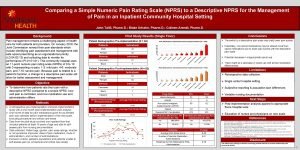Comparing a Simple Numeric Pain Rating Scale NPRS

- Slides: 1

Comparing a Simple Numeric Pain Rating Scale (NPRS) to a Descriptive NPRS for the Management of Pain in an Inpatient Community Hospital Setting John Talili, Pharm. D. ; Blake Urhahn, Pharm. D. ; Colleen Arendt, Pharm. D. Pain management remains a challenging aspect of health care for both patients and providers. On January 2018, the Joint Commission revised their pain standards which include identifying pain assessment and management with safe opioid prescribing as an organizational priority (LD. 04. 03. 13) and collecting data to monitor its performance (PI. 01. 01). This community hospital uses an 11 -point numeric pain rating scale (NPRS) of 0 to 10 with 0 representing no pain, 1 -3: mild pain, 4 -6: moderate pain, and 7 -10: severe pain. Because pain is related to a patient’s function, a change to a descriptive pain scale will allow for better assessment and management. Objective Ø To determine how patients rate their pain with a descriptive NPRS compared to a simple NPRS, how well pain is controlled, and how medication use and administration differs Methods Ø A retrospective pre-implementation and post-implementation study with a one month post-implementation pilot analysis Ø One month of data for pain medications given for as-needed pain was collected before implementation of the new scale, excluding procedural and critical care areas Ø Data from the pilot study involved one inpatient floor that included patients at least 18 years of age and able to selfassess pain from nursing documentation. Ø Data collected: Patient age, gender, pain scale ratings, whether or not symptoms improved, class of pain medication, route of administration, and number of administrations Ø Exclusion criteria: pediatric populations and patients unable to self-assess pain (ie. procedural and critical care areas) Conclusions Pilot Study Results (Single Floor) Background Ø The switch to a descriptive pain scale may yield lower pain scores Patient Demographics Pre-implementation (N = 94) Patients Individuals Male 42 Female 52 Ethnicity Individuals Caucasian 87 Black 7 Ø Potentially, non-opioid medications may be utilized more than opioid medications due to lower pain scores with the descriptive pain scale Ø Potential decrease in inappropriate opioid use Ø There might be a decrease in opioid use with similar medication effectiveness. Patient Demographics Post-implementation (N = 82) Patients Individuals Male 34 Female 48 Ethnicity Individuals Caucasian 74 Black 7 Hispanic 1 Number of Pain Scale Ratings (Pre-Implementation) Average Pain Scale Rating 1026 6. 40 Number of Pain Scale Ratings (Post-Implementation) Average Pain Scale Rating 622 6. 33 Limitations Ø Retrospective data collection Ø Single center hospital setting Ø Subjective reporting & population size differences Drug Class Benzodiazepine NSAID Non-opioid Analgesic: Acetaminophen (APAP) Opioid-APAP Combination Pain Medication Effectiveness Pre -implementation (N = 705) Pre 53 1 60 Post 29 0 62 121 473 73 301 Pain Medication Effectiveness Post -implementation (N = 465) Yes 680 (96%) Yes 453 (97%) No 25 (4%) No 12 (3%) Ø Variable nursing documentation Next Steps Ø Post-implementation analysis applied to appropriate floors hospital-wide Ø Education of nurses and physicians on new scale 1. 2. Outcome P-value Average Pain Scale Score 0. 46 Number of Narcotic Medication Administrations 0. 01 Response to Pain Medications Post. Administration 0. 36 3. 4. 5. 6. References Joint Commission on Accreditation of Healthcare Organizations. (2019). Pain assessment and pain management, including safe opioid prescribing, are identified as an organizational priority for the hospital (LD. 04. 03. 13). Retrieved from https: //edition. jcrinc. com/Main. Content. aspx Joint Commission on Accreditation of Healthcare Organizations. (2019). The hospital collects data to monitor its performance (PI. 01. 01). Retrieved from https: //e-dition. jcrinc. com/Main. Content. aspx Whelan, Emma. Putting Pain to Paper: Endometriosis and the Documentation of Suffering. Health. 2013; 7: 463 -482 Mankoski, Andrea. Mankoski Pain Scale. Retrieved from http: //www. valis. com/andi/painscale. html. Childs JD, Piva SR, Fritz JM. Responsiveness of the numeric pain rating scale in patients with low back pain. Spine (Phila Pa 1976). 2005 Jun 1; 30(11): 1331 -4. Douglas ME, Randleman ML, De. Lane AM, Palmer GA. Determining pain scale preference in a veteran population experiencing chronic pain. Pain Management Nursing. 2014; 15(3): 625 -31. Disclosure The authors have nothing to disclose concerning possible financial or personal relationships with commercial entities.

